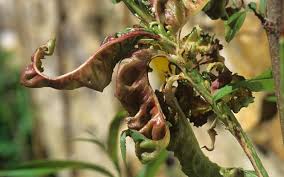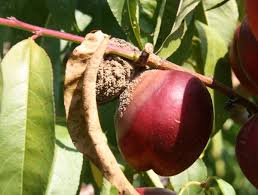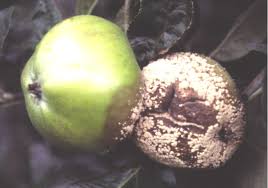


Peach leaf curl, is a disease caused by the fungus Taphrina deformans. (The second name gives you a clue. Deformans)
When using copper sprays. The higher the concentration of copper the more effective the spray will be. We like the Copper-based fungicides like Liqui-Cop that are labeled for use on peaches and nectarines. Spray the entire tree after 90% of the leaves have dropped in the fall and again in the early spring, Spray well to what we call ‘run off’’ Spray also at Pink bud stage, Pink Bud is just before the bud opens up to a flower and looks pink or reddish. Remove all mummified fruit or old leaves. Rake up and destroy old leaves etc. They are the incubator for your next outbreak. Spray when no rain is expected for the next 2 days or so. If you have several different peach tree varieties their flower buds will open on different time schedules. To be effective it is important; that the spray is applied at just the right time. Peach leaf curl affects the blossoms, fruit, leaves, and shootsof peaches, ornamental flowering peaches, and nectarines, and is one of the most common disease problems for backyard gardeners growing these trees. The distorted, reddened foliage that it causes is easily seen in spring. Whe severe, the disease can reduce fruit production substantially.
IDENTIFICATION AND DAMAGE
Peach leaf curl first appears in spring as reddish areas on developing leaves. These areas become thickened and puckered, causing leaves to curl and severely distort. The thickened areas turn yellowish and then grayish white, as velvety spores are produced on the surface by the leaf curl fungus. Later affected leaves turn yellow or brown and can remain on the tree or may fall off; they are replaced by a second set of leaves that develop more normally unless wet weather continues. The loss of leaves and the production of a second set result in decreased tree growth and fruit production.
—Monilinia spp. Brown Rot on peaches and nectarines
Blossoms on plants infected with Monilinia brown and wither. Dead blossoms often cling to twigs for a long time. Sunken, brown areas may develop around twigs at the base of infected flowers, causing leaves at the tips of twigs to shrivel up. Brown, sticky droplets of gum may exude from the base of dead flowers and the bark of infected twigs. Velvety gray or tan tufts of spores are formed on diseased blossoms or twig cankers. When fruit appears, it will have brown rotting areas on each fruit making them unappealing and inedible. Brown or tan spots spread rapidly over the fruit surface and produce spores.
SOLUTIONS
Prompt removal and destruction of fruit mummies and diseased plant parts prevents the buildup of brown rot inoculum and helps keep rot below damaging levels. Prune trees to allow good ventilation. Furrow irrigate or use low-angle sprinklers to avoid wetting blossoms, foliage, and fruit. Plant varieties that are least susceptible; check with your local nurseryman. If you have had problems in the past, apply fungicides or synthetic fungicides such as LIQUI-Cop at pink bud stage can help avoid serious losses. Additional applications when fruit starts to color may be needed if rainy weather persists. Do not apply copper compounds after bloom.
Disclaimer: Remember we are not certified Pest Control operators. As with any advice; always read and follow the directions. Wear protective clothing and wash thoroughly after any spraying. Do not use if you are allergic to any of the ingredients. When using the Web remember the www. stands for World Wide Web. For the best information be sure you are looking at a California site not some advice from Scotland or South America. Even in California the climate can be very different. What works in Northern California may not be the best for our dryer Southern California weather.
